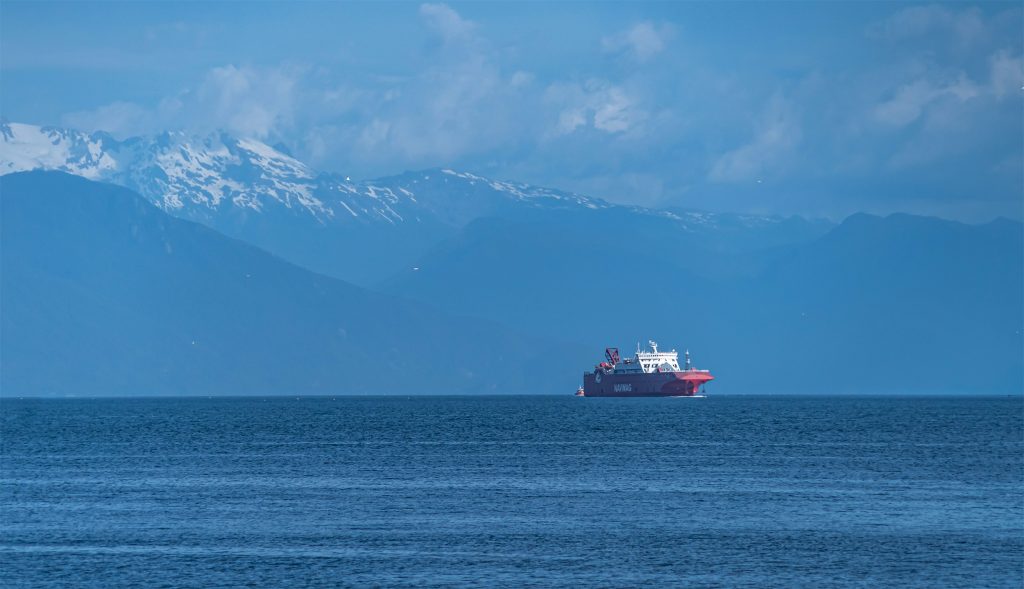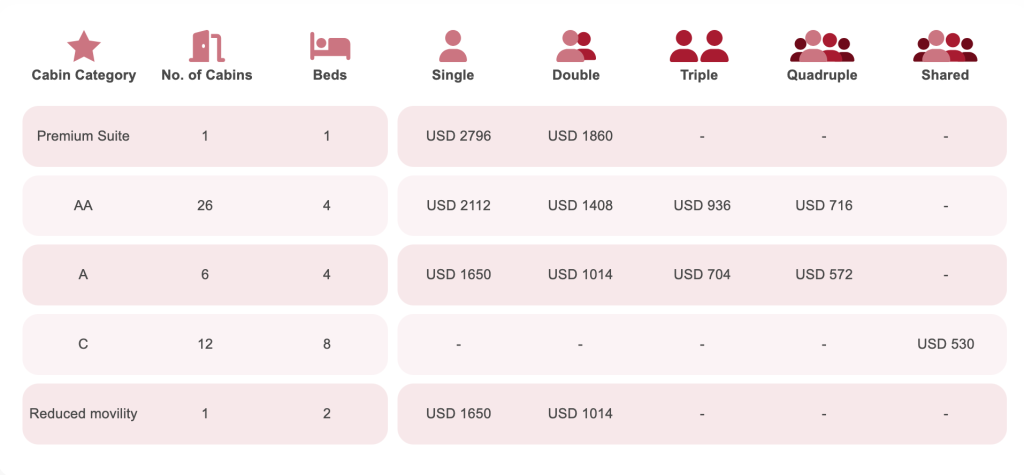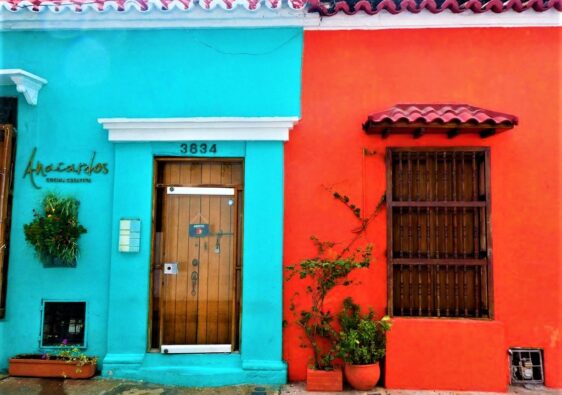Traveling by ferry along the Patagonian fjords is one of the most unique journeys in Chile—and indeed all of South America. It’s slow-paced travel at its finest, where days unfold at the rhythm of the sea. Passengers gaze out at towering snow-capped mountains, emerald fjords, remote islands, and immense glaciers, while dolphins, sea lions, and seabirds often make appearances along the way. All of this can be admired in comfort, whether from the ship’s open decks or from the warmth of your own cabin window.
This extraordinary route is made possible by Navimag Ferries, a Chilean company that has been connecting the south Chilean cities, Puerto Montt and Puerto Natales since the late 1970s. Originally created to move cargo, Navimag opened its decks to adventurous travelers decades ago, offering them a rare opportunity to explore Patagonia by sea. Today, the company operates the Esperanza, a modern passenger-cargo ferry launched in 2021, which carries both freight and curious travelers through one of the wildest stretches of coastline on the planet.

The Puerto Montt–Puerto Natales Route at a Glance
Esperanza ferry runs from October to March with passengers, on a route of 1700 km (1056 mi). The boat sails roughly once a week in each direction, although the exact schedule changes depending on the season and weather. For example, in the 2025/2026 season the ferry leaves Puerto Montt port on Fridays from October until the beginning of January, and then it varies between the days of the week. The departure day is Tuesday from Puerto Natales for the beginning of the season, and then it varies as well. Always check the timetable on Navimag’s site brochure.
Due to currents, the voyage has a different duration on the two directions:
- From Puerto Montt to Puerto Natales: 4 days and 3 nights
- From Puerto Natales to Puerto Montt: 3 days and 4 nights
Departures are from/to Puerto Montt’s ferry terminal and Puerto Natales’ small ferry port.
As of August 2025, the price for a foreign adult ticket in the most basic service level starts at USD $530. Higher-class cabins are available at increased rates, which we’ll explore later in this article.
Meet the Esperanza: Navimag’s Passenger-Cargo Ferry
Navimag’s Esperanza (means “Hope” in English) was built in 2019 to cater for moving cargo and for traveling a maximum of 244 passengers. It is not a luxury cruise liner but a working cargo ship with passenger facilities. Expect to share space with adventurous backpackers, Chilean travelers, and truck drivers moving cargo (sometimes including livestock) south. Accommodation ranges from shared dorm-style berths to private cabins with bathrooms. Common spaces include lounges with large windows, a cafeteria where meals are served, a coffee shop and open decks for wildlife and scenery spotting.
If you have a car, a motorcycle or bicycle, you can transport that on the ferry as well.
Life On Board: What to Expect
Life on the ferry is simple. Meals are included and served at set times in the cafeteria. There is no Wi-Fi and little to no cell service, so the journey becomes an enforced digital detox. Many travelers pass the time reading, journaling, playing cards, or simply gazing out the window at the dramatic landscapes. A daily yoga class held on the dock/in the gym is also included in the price. In the October-April high season there’s entertainment on board in the form of talks, karaokee, bingo – led by professional tourist/entertainment guides. Overall, the atmosphere is social but laid-back, with passengers sharing stories over meals.
Included in all tickets:
- All meals (breakfast, lunch, dinner)
- Coffee, tea, water, fruits available at all times
- Yoga class
- Bilingual tourist and entertainment guide
- Daily cabin cleaning
All cabins include bathrooms, and all beds have bed linen and a towel.

The Journey Day by Day
From Puerto Montt to Puerto Natales
Day 1: Departure from Puerto Montt
During check-in at Puerto Montt ferry port, port staff will take care of your luggage, which passengers then collect when boarding the ferry. Those traveling with vehicles will receive clear instructions to guide them through the embarkation process. Once on board, the crew welcomes everyone with a safety briefing and practical information to ensure a comfortable journey. Soon after, the ship sets sail into the Patagonian fjords. The voyage begins by passing through the Reloncaví Sound and the Gulf of Ancud, before entering the Apiao Channel at dusk and continuing toward the Gulf of Corcovado.
Day 2: Canal Moraleda > Oceanic Area > Gulf Penas
At sunrise, the journey continues through the southern reaches of the Gulf of Corcovado. When conditions are favorable, passengers may spot dolphins, sea lions, and a variety of seabirds gliding above the waves. As evening falls, the ferry leaves the sheltered channels and begins its ocean passage north of the Gulf of Penas, entering the open sea overnight. This crossing takes around 12 hours, and with a bit of luck, travelers might witness humpback, minke, or even blue whales along the way.
Day 3: Cross the Gulf of Penas, the roughest section of open sea.
Day 4: Glide into the sheltered fjords and finally arrive in Puerto Natales.
Day 3: Bajo Cotopaxi > Puerto Edén
Morning finds us surrounded by fjords as the ship makes its way through the Messier Channel, whose waters plunge to a depth of 1,270 meters. Along the way, passengers can spot the Capitán Leonidas, a cargo ship stranded since the 1970s on a submerged islet known as Bajo Cotopaxi. Today, its rusting hull serves as both a navigation beacon and a striking landmark for sailors. Soon after, the ferry continues through the Angostura Inglesa before reaching the remote settlement of Puerto Edén. This tiny village, located on Wellington Island—one of the largest in Chile—is home to the last remaining Kawésqar people and forms part of the vast Bernardo O’Higgins National Park.
Day 4: Paso Kirke > Puerto Natales
At dawn the ferry glides through the tranquil waters of the Santa María Channel, before approaching the narrowest stretch of the entire journey—Angostura White, just 80m (262 feet) wide. From there, the route continues through the Unión Pass and into the channel that leads directly to Puerto Natales, where this unforgettable Patagonian voyage gently draws to a close.
From Puerto Natales to Puerto Montt
Day 1: Departure from Puerto Natales
As part of the check-in process, staff will take care of your luggage, which you’ll collect at the time of boarding. If you’re traveling with a vehicle, you’ll receive clear instructions to guide you through the embarkation process. Once underway, the ferry first passes through the Unión Pass before reaching the narrowest point of the journey—Angostura White, a channel only 80m (262 feet) wide—before continuing on through the Santa María Channel.
Day 2: Paso Kirke > Canal Santa María > Paso Sobenes
The ferry navigates a series of stunning channels, including Morla Vicuña, Unión Pass, Farquar, Sarmiento, and Angostura. Along the way, it passes Puerto Edén, home to Chile’s last remaining Kawésqar community. This remote settlement sits on Wellington Island, one of the country’s largest, within the vast Bernardo O’Higgins National Park. Continuing north, the vessel enters the Angostura Inglesa, a narrow channel so tight that only one ship can pass at a time, before reaching the Messier Channel, where the historic cargo ship Capitán Leonidas has rested since the 1970s atop the semi-submerged islet known as Bajo Cotopaxi.
Day 3: Gulf Penas > Oceanic Area > Canal Moraleda
The ferry enters the open waters of the Gulf of Penas, beginning a roughly 12-hour oceanic crossing. During this stretch, travelers may be lucky enough to spot humpback, minke, or blue whales. After navigating the open sea, the vessel continues through the Chacabuco Channel and the Errázuriz Channel, before entering the Moraleda Channel and following the scenic route through the Chonos Archipelago on its way to Puerto Montt.
Day 4: Puerto Montt > Check-out
On the northbound journey, the ferry glides through the Gulf of Corcovado, continues along the Apiao Channel and the Gulf of Ancud, and passes through the Reloncaví Sound before arriving in Puerto Montt in the morning, marking the conclusion of your unforgettable Patagonian adventure.
Who Is This Trip For?
This is not a luxury cruise. It’s better suited for travelers who appreciate slow journeys, backpackers looking for an unusual route south, photographers chasing dramatic landscapes, and anyone seeking an off-the-grid experience, while appreciate having a bed for the night.
Practical Tips Before You Sail
Ferry ticket costs
Ticket costs depend on the accommodation type you choose. The cheapest berths in shared dorms cost USD $530, while the most expensive single private cabin with bathroom exceeds USD $2,700. Some other example prices: a private cabin for 4 people costs USD $716 per person. The cheapest private cabin for 2 people costs USD $1014 per person. The below table shows the prices per passenger for the different cabins, and how many cabins are available from them. Children 3-12 years get 20% discount. All prices above and in the below table are per passenger, and are valid for the 2025/2026 season based on Navimag’s site at the time of writing this article in Aug 2025.

On the top of the above ticket prices, there’s a 10 USD boarding fee per passenger.
Booking tickets
Tickets can be booked directly online at navimag.com, via email on [email protected], through some travel agencies in Chile, or in person at Navimag offices. Because sailings are weekly and can sell out in high season (December–February), it’s best to book at least 1–2 months in advance.
During the booking process you’ll have the possibility to select the number and type of cabin and any special dietary requirements (for exampe, if you want vegetarian meals). Purchases can only be done in USD or CLP (Chilean Pesos). If your trip is at least 60 days ahead, you’ll have the possibility to pay only 30% at the time of the booking, and the rest later.
What to bring on board
- Prepare for living and sleeping on the ferry for a couple of days by bringing pyjamas, hygiene products, and entertainment such as books or downloaded podcasts
- Bring warm clothes (layers are key) as on the deck it tends to be windy and cold
- Consider seasickness medication for the Gulf of Penas crossing, where the waves are big all year round. Passing this part takes about half a day.
Other practical tips
- There can be delays in the ferry service, both in departure and arrival. This is often due to weather conditions or special needs of the cargo transported. So it’s best not to organise other activities too close to the arrival time
- Pets are only allowed to travel in the cargo section, not in the cabin
- It’s recommended to book travel insurance for your trip in Patagonia
Puerto Montt and Puerto Natales: Before and After Your Voyage
Puerto Montt is a bustling southern port town, known for its seafood market at Angelmó. It’s worth arriving a day early to explore and ensure you don’t miss your sailing.
Puerto Natales, on the other end, is a charming gateway town to Torres del Paine National Park. Budget at least a few days here to take in the scenery, stock up on supplies, or join a trekking tour.
Read our guide to Puerto Natales
Alternative Transport Methods Between Puerto Montt and Puerto Natales
For those short on time, there is another option to travel between Puerto Montt and Puerto Natales without taking the ferry:
Flight + Bus: You can fly from Puerto Montt to Punta Arenas (about 2.5 hours, with fares from USD $80–$150 depending on season and airline). From there, it’s a 3-hour bus ride to Puerto Natales for about USD $15–$20. This is the fastest way to get south, usually taking under 6 hours total.
Since there’s no continuous road between the two cities, there’s no direct bus connection.
If you want to experience a ferry trip in Patagonian fjords, but cheaper, consider the Tabsa ferry that connects Puerto Natales to Caleta Tortel. Read about it in our article.



